James River Coal Co. Bundle
What Went Wrong at James River Coal Co.?
Delve into the James River Coal Co. SWOT Analysis to understand the rise and fall of a prominent player in the American coal industry. From its inception in Virginia in 1991, James River Coal Co. aimed to dominate the market. Discover the key events and strategic decisions that shaped the company's trajectory, impacting the Appalachian coal landscape.
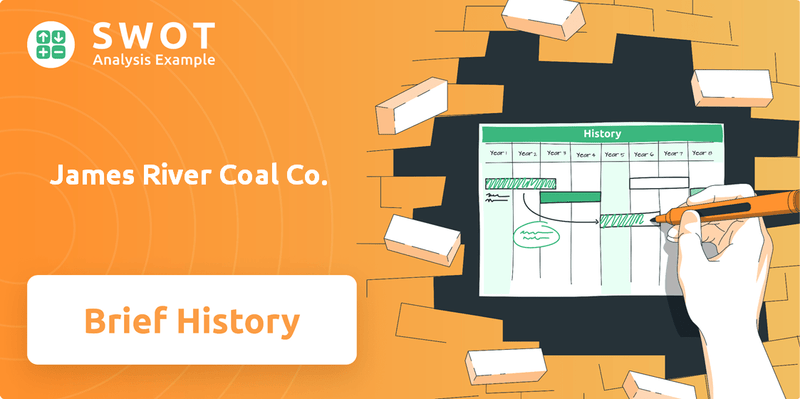
The James River Coal Company history is a compelling case study of the coal mining company's struggles. Initially focused on steam and metallurgical coal, the company expanded its operations across Central Appalachia and the Illinois Basin. The eventual bankruptcy highlights the volatile nature of the coal industry and the challenges faced by Virginia coal producers.
What is the James River Coal Co. Founding Story?
The story of James River Coal Co. began in 1988. It was formed through the acquisition of McCoy Elkhorn and Bell County from Transco Coal Company. This marked the initial step into the competitive world of coal mining.
The company's formal establishment occurred in June 1991. It was incorporated in the Commonwealth of Virginia, with its main offices in Richmond. This set the stage for its operations within the coal industry.
James River Coal Co. focused on mining, processing, and selling various grades of coal. Its primary customers were electric utility companies, particularly in the southeastern United States. The company quickly established a significant presence in the Appalachian coal region.
Here's a look at the early days of the company and its strategic focus.
- The company's initial business model was centered on mining, processing, and selling bituminous, low sulfur, steam, and industrial-grade coal.
- Its primary customers were electric utility companies in the southeastern United States.
- In 2004, approximately 83.4% of their revenue came from coal sales to electric utility companies.
- James River Coal Sales, Inc., formerly known as Blue Crystal Coal Sales Company, was a subsidiary focused on coal sales.
The company's operations were heavily reliant on sales to electric utilities. This made it sensitive to changes in the energy market. The Owners & Shareholders of James River Coal Co. played a crucial role in guiding the company through the evolving dynamics of the coal industry.
James River Coal Co. SWOT Analysis
- Complete SWOT Breakdown
- Fully Customizable
- Editable in Excel & Word
- Professional Formatting
- Investor-Ready Format
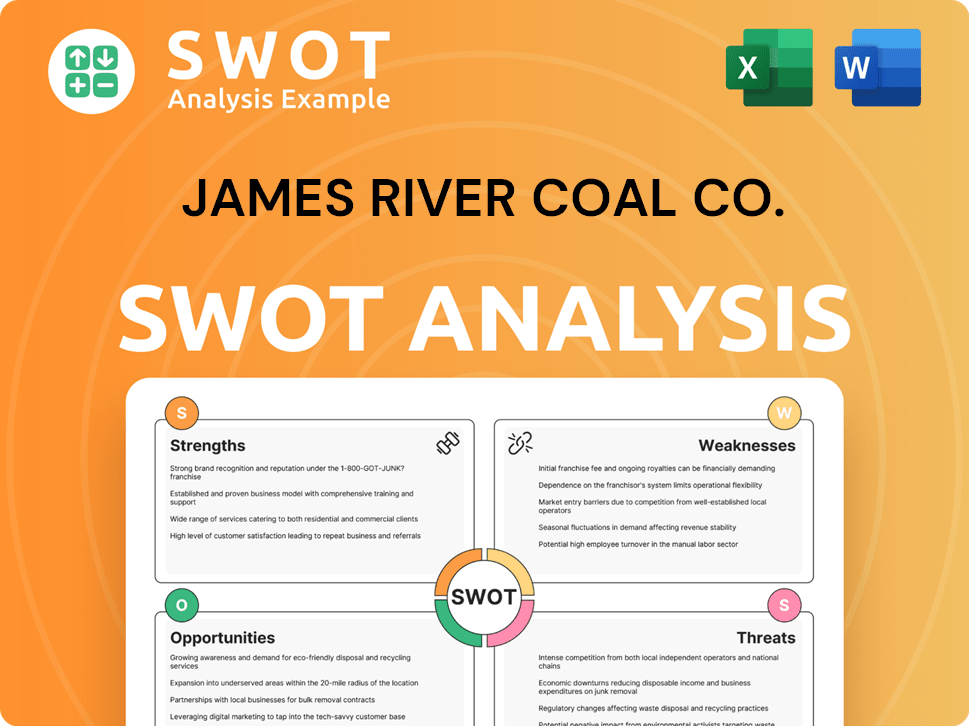
What Drove the Early Growth of James River Coal Co.?
The early growth of the James River Coal Co. involved strategic acquisitions to expand its operations and coal reserves. This expansion was crucial in the company's development within the coal industry. The company's acquisition strategy significantly shaped its production capacity and market reach, contributing to its position in the Appalachian coal region.
In 1992,
In June 1995, James River Coal Co. acquired Leeco and Bledsoe operating companies through Transco Coal Company. The company purchased Blue Diamond in 1998. In 1999, it acquired Shamrock Coal Company, which added more mines, reserves, and a preparation plant to the Bledsoe complex.
In May 2005, James River Coal Co. purchased Triad Mining, Inc., diversifying its operations into the Illinois Basin. In 2004, the company produced 8.5 million tons of coal and purchased an additional 330,000 tons for resale. This generated revenues of $345.6 million.
A significant acquisition occurred in April 2011 with the purchase of International Resource Partners (IRP) for $475 million. This acquisition added high-quality metallurgical and steam coal production and reserves. By December 31, 2011, the company controlled 362.8 million tons of probable coal reserves and produced 10.3 million tons of coal.
James River Coal Co. PESTLE Analysis
- Covers All 6 PESTLE Categories
- No Research Needed – Save Hours of Work
- Built by Experts, Trusted by Consultants
- Instant Download, Ready to Use
- 100% Editable, Fully Customizable
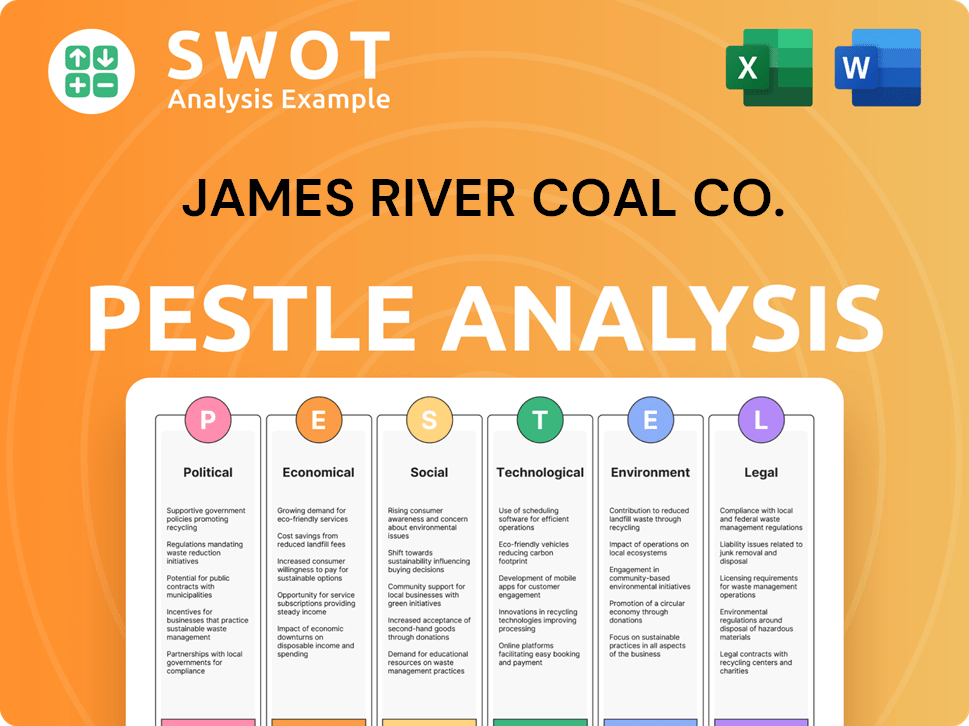
What are the key Milestones in James River Coal Co. history?
The James River Coal Co company history is marked by significant production achievements and strategic expansions within the coal industry.
| Year | Milestone |
|---|---|
| 2004 | Produced 8.5 million tons of coal, with 96.5% from underground mines. |
| 2009 | Sold 9.6 million tons of coal. |
| April 2011 | Acquired International Resource Partners (IRP) for $475 million, expanding metallurgical and steam coal capabilities. |
While specific innovations are not widely documented, the company focused on expanding its operational capacity and market reach through acquisitions and strategic sales volumes. These efforts aimed to capitalize on the demand within the Appalachian coal region and beyond.
The company's primary focus was on achieving high production volumes, as demonstrated by the 8.5 million tons of coal produced in 2004. This indicates a strong operational capacity.
The acquisition of IRP in April 2011 for $475 million was a strategic move to broaden its coal types and market presence. This expanded its portfolio into both metallurgical and steam coal.
The James River Coal Co faced substantial challenges, including declining demand and increased competition. The coal mining company struggled with environmental regulations and economic downturns, leading to significant financial distress.
In 2013, sales to U.S. power plants decreased by 30.1% to approximately 4.2 million tons. This drop in sales directly impacted the company's revenue.
The company's second-quarter revenue in 2013 dropped by 42%. This significant decline reflected the severity of the challenges it faced.
On April 7, 2014, James River Coal Co. and its subsidiaries filed for Chapter 11 bankruptcy. This was a direct result of the financial strain.
The company sold its assets, with operations in West Virginia and Indiana going to Blackhawk Mining, and Kentucky operations to Revelation Energy, Blackhawk Mining, and Fortress Resources. The sale of its remaining operating assets was completed on December 31, 2014.
James River Coal Co. Business Model Canvas
- Complete 9-Block Business Model Canvas
- Effortlessly Communicate Your Business Strategy
- Investor-Ready BMC Format
- 100% Editable and Customizable
- Clear and Structured Layout
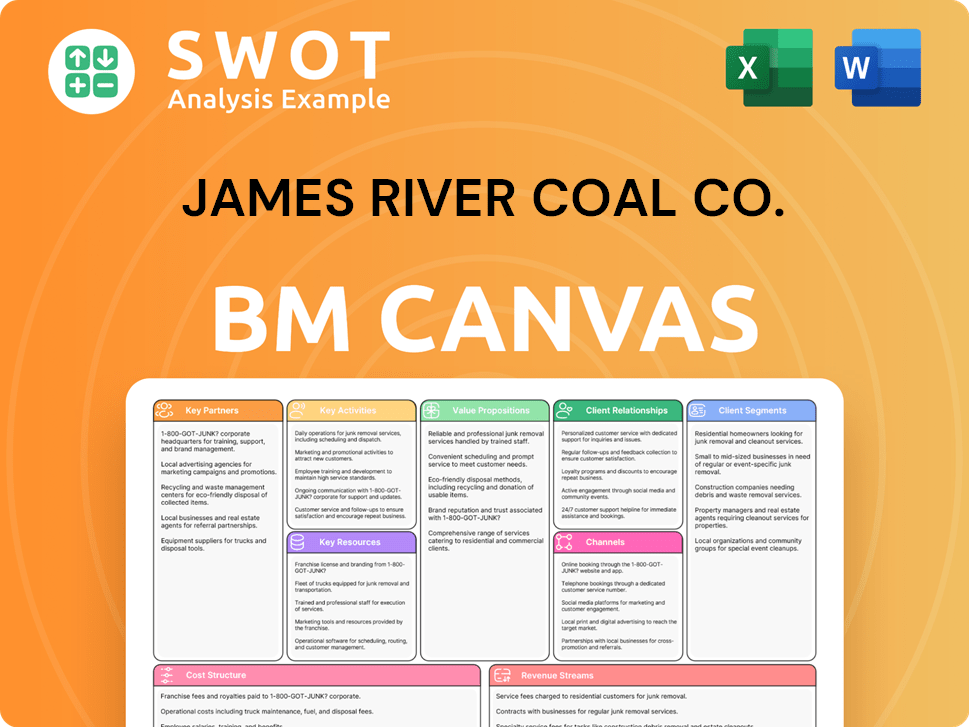
What is the Timeline of Key Events for James River Coal Co.?
The James River Coal Co, a significant player in the coal industry, experienced a series of pivotal events throughout its operational history. From its formation in 1988 to its ultimate dissolution, the company navigated the volatile coal market. The following table outlines key milestones in the
| Year | Key Event |
|---|---|
| 1988 | The James River Coal Company was established through the acquisition of McCoy Elkhorn and Bell County from Transco Coal Company. |
| June 1991 | The company was incorporated in the Commonwealth of Virginia. |
| 1992 | Johns Creek Coal Company was acquired. |
| June 1995 | Leeco and Bledsoe operating companies were acquired. |
| 1998 | Blue Diamond operating company was purchased. |
| 1999 | Shamrock Coal Company was acquired. |
| 2004 | The company produced 8.5 million tons of coal, generating $345.6 million in revenues. |
| May 2005 | Triad Mining, Inc. was purchased. |
| April 2011 | International Resource Partners (IRP) was acquired for $475 million. |
| September 2013 | Production was idled at several Central Appalachian locations, leading to the furlough of 525 employees due to market weakness. |
| April 7, 2014 | The company filed for Chapter 11 bankruptcy protection. |
| August 21, 2014 | A $52 million bid from Blackhawk Mining was accepted for three mining complexes. |
| August 31, 2014 | The company's defined benefit pension plan was terminated. |
| December 31, 2014 | The sale of all remaining operating assets was completed. |
The global coal market is in constant flux. In 2024, global coal consumption grew by 1.2%, with the electricity sector being the primary driver. Despite record-high coal power generation, coal's share in the electricity mix is falling. This reflects broader shifts in energy production and consumption worldwide.
Coal prices are projected to decline. A 27% decrease is expected in 2025, followed by an additional 5% drop in 2026. The U.S. coal production declined by 60 million metric tons in 2024. These trends indicate a challenging environment for coal producers.
The future of the coal industry is shaped by several factors. Expanding renewable energy sources and stricter environmental regulations are significant influences. Emerging markets, like China and India, will continue to impact demand. These factors will influence the
James River Coal Co. no longer exists as an operational entity. The company's initial goal of being a major coal producer was affected by market changes and economic pressures. The company's history reflects the broader challenges faced by the
James River Coal Co. Porter's Five Forces Analysis
- Covers All 5 Competitive Forces in Detail
- Structured for Consultants, Students, and Founders
- 100% Editable in Microsoft Word & Excel
- Instant Digital Download – Use Immediately
- Compatible with Mac & PC – Fully Unlocked
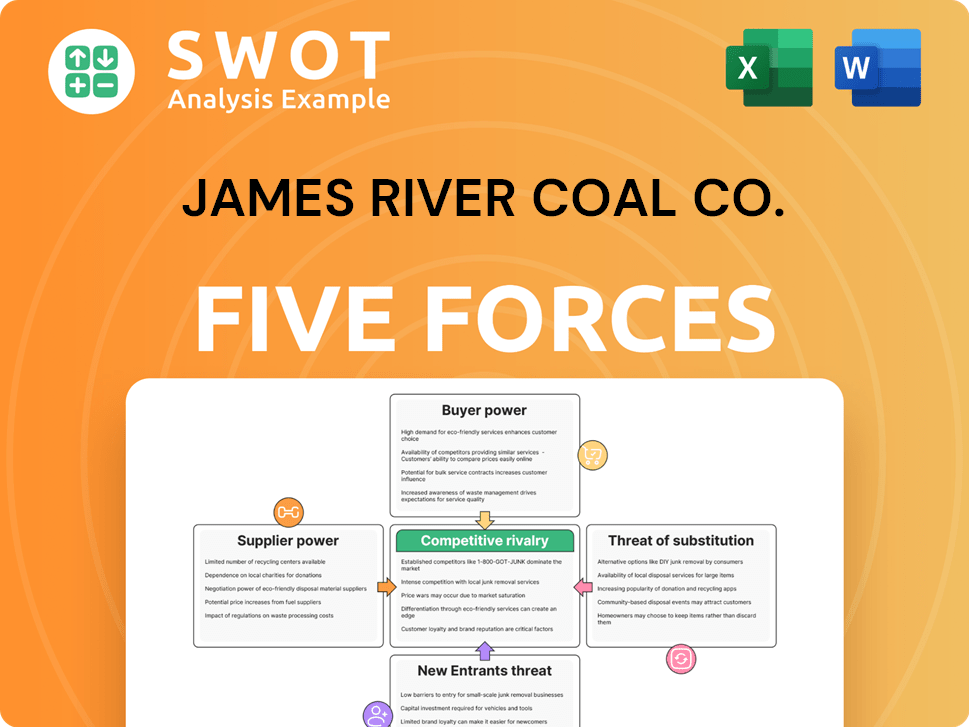
Related Blogs
- What is Competitive Landscape of James River Coal Co. Company?
- What is Growth Strategy and Future Prospects of James River Coal Co. Company?
- How Does James River Coal Co. Company Work?
- What is Sales and Marketing Strategy of James River Coal Co. Company?
- What is Brief History of James River Coal Co. Company?
- Who Owns James River Coal Co. Company?
- What is Customer Demographics and Target Market of James River Coal Co. Company?
Disclaimer
All information, articles, and product details provided on this website are for general informational and educational purposes only. We do not claim any ownership over, nor do we intend to infringe upon, any trademarks, copyrights, logos, brand names, or other intellectual property mentioned or depicted on this site. Such intellectual property remains the property of its respective owners, and any references here are made solely for identification or informational purposes, without implying any affiliation, endorsement, or partnership.
We make no representations or warranties, express or implied, regarding the accuracy, completeness, or suitability of any content or products presented. Nothing on this website should be construed as legal, tax, investment, financial, medical, or other professional advice. In addition, no part of this site—including articles or product references—constitutes a solicitation, recommendation, endorsement, advertisement, or offer to buy or sell any securities, franchises, or other financial instruments, particularly in jurisdictions where such activity would be unlawful.
All content is of a general nature and may not address the specific circumstances of any individual or entity. It is not a substitute for professional advice or services. Any actions you take based on the information provided here are strictly at your own risk. You accept full responsibility for any decisions or outcomes arising from your use of this website and agree to release us from any liability in connection with your use of, or reliance upon, the content or products found herein.